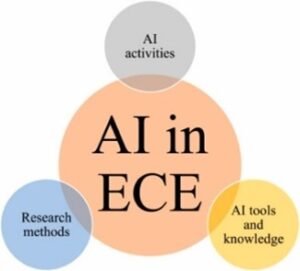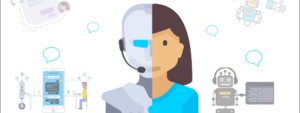ISSN-2348-8824(Print), 3048-5061 (Online)
RNI No: HARENG/2021/35200
Vol, XIV, No. 2 December 2023 – March-2024
By Nisha B. Nair
ABSTRACT
Educational technology constitutes an important aspect of modern education providing unique learning experiences to students and improving their learning. Technological resources (especially computers) have been integrated into education for decades. However, the integration of educational technology in early childhood education is a more recent trend compared to the other levels of education. This fact creates the need to develop, apply, and study the application of resources and methodologies specifically addressed to young children. Artificial Intelligence approaches have been incorporated into educational technology resources providing improved interaction for learners.

Computer-based learning is a significant aspect of educational technology. Computers have been used in education since the 1950s so that they may be exploited in multiple ways by students and teachers working individually and in groups. However, educational technology usually involves a combination of resources besides computers to exploit the corresponding characteristics and the advantages offered by each type of resource. This is especially the case in early childhood education. Popular types of technological resources used in early childhood education besides computers are interactive whiteboards and interactive toys.
Game consoles and robots may also become popular in early childhood education. Early childhood education curriculum covers several aspects such as language, science, mathematics, arts, and special education. Early childhood education involves both teacher-directed and student-centered activities putting emphasis on collaboration, constructivism, and interdisciplinary tasks. Students interact with resources available in the classroom during structured and non-structured activities.
Game-based learning possesses an important role as it promotes collaboration and creativity in an appealing way for young children.
INTRODUCTION
Intelligent Educational Robots for Young Children

A number of research efforts have been presented that involve the integration of intelligent robots in early childhood contexts. The present research approaches mostly involve robots integrated into a classroom or clinical setting. Robots may be exploited at home as well. There are also general research efforts concerning robot-child interaction in any type of setting such as approaches regarding methods for recording and analysing interaction data. Interesting approaches addressed to children with special needs have also been presented. In classroom settings, robots are used for edutainment purposes. Children may learn about, from, and with robots. Children learn about robots as they constitute a technology that according to certain predictions will be available in most homes in the near future. Robots may function as teaching assistants providing learning and social activities. Children may also learn with robots since after long-term child-robot interaction, children may regard robots as peers.
AI in kindergarten and AI in secondary and higher education are very different. AI in kindergarten focuses on basic concepts and simple AI activities (e.g., drawing concept maps and AI framing). However, AI in secondary and higher education focuses on programming (e.g., Scratch and Google Teachable Machine), and complex concepts. Kindergarten children need to learn AI. There are many benefits for kindergarten children to learn AI. For example, children enhanced computational thinking skills and problem-solving skills through AI activities and improved AI knowledge through AI curriculum. Furthermore, young children playing with the AI robot improved several inquiry literacy skills (i.e., creative inquiry, emotional inquiry, and collaborative inquiry skills).
What is AI for Kids?

“AI for Kids” refers to educational initiatives and resources designed to introduce children to the concepts and applications of Artificial Intelligence. This can range from simple coding exercises and interactive games to more advanced projects, such as building AI-powered websites or robots. The goal of AI for kids is to provide hands-on learning experiences that foster critical thinking, problem-solving, and creativity skills, as well as prepare them for future career opportunities in AI.
Emerging Trends and Research in Artificial Intelligence
Nowadays, Artificial Intelligence (AI) literacy has become an emerging topic in digital literacy education research. However, it is still under-explored in early childhood education (ECE) since the AI curriculum for young children has just been designed in recent years. A scoping review was conducted to examine the thematic and content analysis of 16 empirical papers from the years 2016 to 2022. This scoping reviews evaluate, synthesize, and display 16 studies on AI literacy in early childhood education, including curriculum design, AI tools, pedagogical approaches, research designs, assessment methods, and findings. The discussion of the AI literacy implementation in ECE contributes to providing references for educators and researchers to design interventions to engage young children in AI learning. Further we identified a set of challenges and opportunities for AI literacy. Several challenges included:
- 1. lack of teachers’ AI knowledge, skills, and confidence.
- 2. lack of curriculum design; and
- 3. lack of teaching
Although educators meet challenges at the beginning stage of developing AI instructional design for young children, AI learning could bring learning opportunities and foster young children’s AI literacy in terms of AI concepts, practices, and perspectives.
Five Emerging Trends in Deep Learning and Artificial Intelligence
Following are the five emerging trends in deep learning and artificial intelligence that needs to be explored:
Federated Learning
Federated learning is a machine learning approach that allows multiple devices to collaborate on a single model without sharing their data with a central server. This approach is beneficial in situations where data privacy is a concern.
Generative Adversarial Networks (GANs)
Generated Adversarial Networks are a type of neural network that can be used to generate new, realistic data based on existing data. For example, GANs have been used to generate realistic images of people, animals and even landscapes. GANs work by pitting two neural networks against each other, with one network generating fake data and the other network trying to detect whether the data is real or fake.
Explainable AI (XAI)
An approach to AI known as Explainable AI (XAI) aims to increase the transparency and comprehension of machine learning models. XAI is crucial because it can guarantee that AI systems make impartial, fair decisions.
Reinforcement Learning
A type of machine learning called Reinforcement Learning includes teaching agents to learn via criticism and incentives. Many applications, including robotics, gaming, and even banking, have made use of this strategy. For instance, DeepMind’s AlphaGo used this approach to continually improve its gameplay and eventually defeat top human Go players, demonstrating the effectiveness of reinforcement learning in complex decision-making tasks.
Transfer learning
A machine learning strategy called Transfer Learning involves applying previously trained models to address brand-new issues. When there is little data available for a new problem, this method is especially helpful.
Benefits of AI Education in Early Childhood
-
- Building Critical Thinking and Problem-Solving Skills
- Fostering Creativity and Innovation
- Preparing for Future Career Opportunities

Steps to Encourage AI Education for Kids
(i) When to Start Learning AI?
The best age for kids to learn AI is around 8-10 years. AI for kids at this age can be introduced through fun and educational activities, allowing them to develop a solid foundation in the basics of AI and its applications. Starting early also gives kids the opportunity to gain a deeper understanding of AI and its potential impact on society, preparing them for a future in a technology-driven world.
(ii) Recommended Tools and Technologies for AI Learning
AI for kids’ learning can be facilitated with various tools and technologies, including educational coding platforms, robotics kits, and virtual or augmented reality experiences. Additionally, online resources such as AI learning courses and tutorials can also be valuable for kids looking to better their understanding of AI. The best option could be to use expert guidance who can help your kid navigate through the universe of AI easily and in a fun and interactive way.
(iii) Parental Support for AI for Kids
Parental support is crucial for AI for kids’ education, as it can help provide the resources, encouragement, and guidance necessary for kids to succeed. By helping kids access educational tools and resources, fostering their interests in AI, and encouraging their learning and exploration, parents can play an essential role in helping kids develop the skills and knowledge necessary to succeed in a technology-driven world. With the proper support, kids can thrive in their AI education and be well-prepared for a future filled with exciting opportunities.
Drawbacks of Using AI in Early Education
- 1. Reduces Students’ Capacity for Thought
The use of artificial intelligence in schools has numerous drawbacks. The biggest one is that it reduces kids’ ability to think critically and increases their reliance on technology rather than teaching them how to complete tasks independently.
2. Communication Gap
There are many drawbacks to artificial intelligence in education, but the most significant drawback is that there would be a huge communication gap between teachers and students if robots were used as part-time instructors during school hours rather than people because they could not interact socially with each other as people would.
3. Addiction to Artificial Intelligence
Use of Artificial intelligence can easily become an addiction. The use of artificial intelligence in education has some drawbacks, including the possibility that students will become less interested in learning as they become more interested in AI equipment.
4. Issues with Maintenance
Artificial intelligence in education has a number of maintenance-related drawbacks. Authority should always keep an eye on everything AI does, for instance, AI has a finite body of knowledge and thus can have unintended repercussions if it exceeds its capabilities.
CONCLUSION
AI for kids provides a wealth of opportunities for children to explore and learn about this cutting-edge technology. From developing AI-powered websites and animations to delving into Robotics and understanding the connection between these fields, kids can gain hands-on experience and develop their critical thinking, problem-solving, and creativity skills. As AI continues to shape the future and create new career opportunities, it is essential for kids to start learning about AI early and develop the skills necessary to thrive in the digital age. However, only the right guidance and a balanced approach will reap the desired results.
REFERENCES
https://researchgate.net/publication/287644942_Artificial_Intelligence_Methods_in_Early_Childhood_Education
- https://www2.ed.gov/documents/ai-report/ai-report.pdf
- https://iopscience.iop.org/article/10.1088/1742-6596/1302/3/032043/pdf
- https://sciencedirect.com/science/article/pii/S2666920X22000273
ABOUT THE AUTHOR
Ms. Nisha. B. Nair is an educationist with 17 years of vibrant teaching experience and her work has left an indelible mark on the landscape of early childhood education, influencing both research and practice. She is currently serving as HOD, Economics Department, Good Shepherd Public School. Her insights continue to shape the conversation surrounding the optimal conditions for fostering a strong foundation for lifelong learning.
Nisha B. Nair
Department of Economics
Good Shepherd Public School & Junior College Thengana,
Kottayam, Kerala








